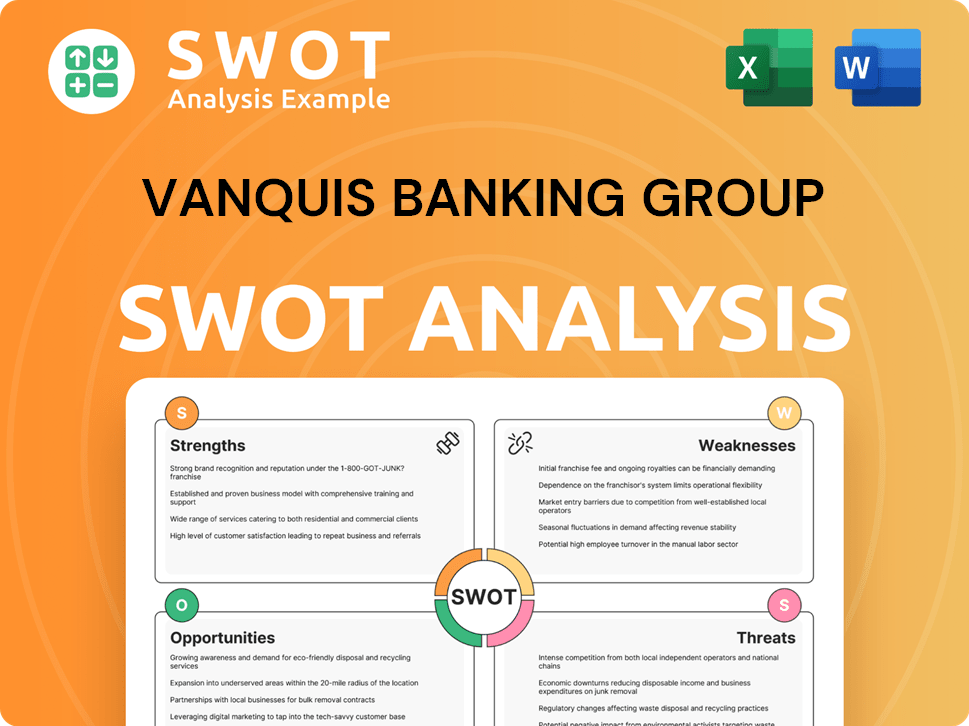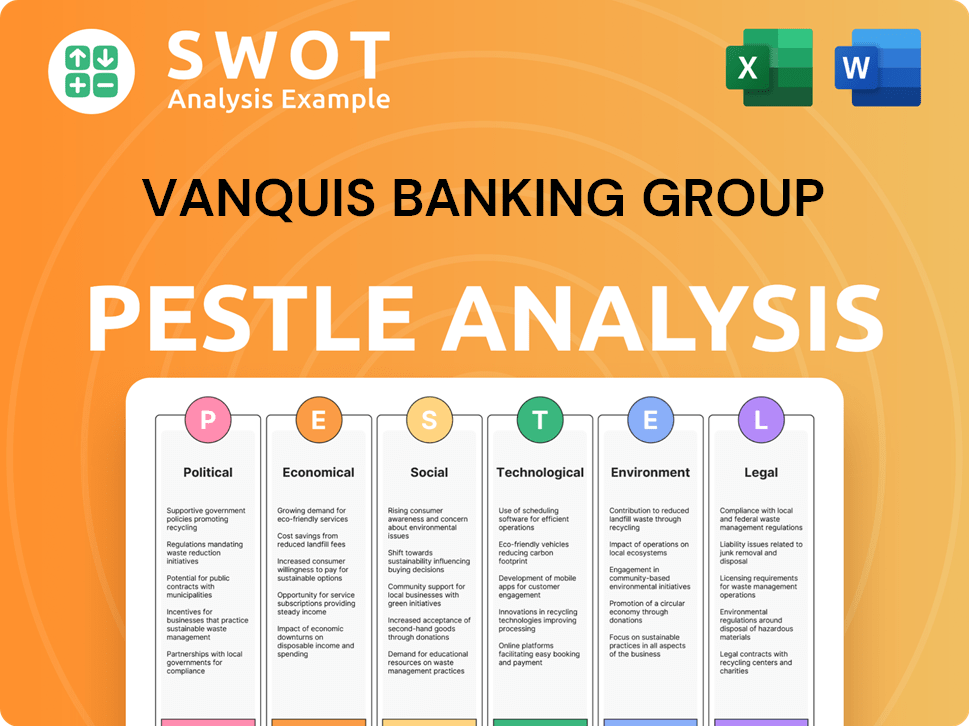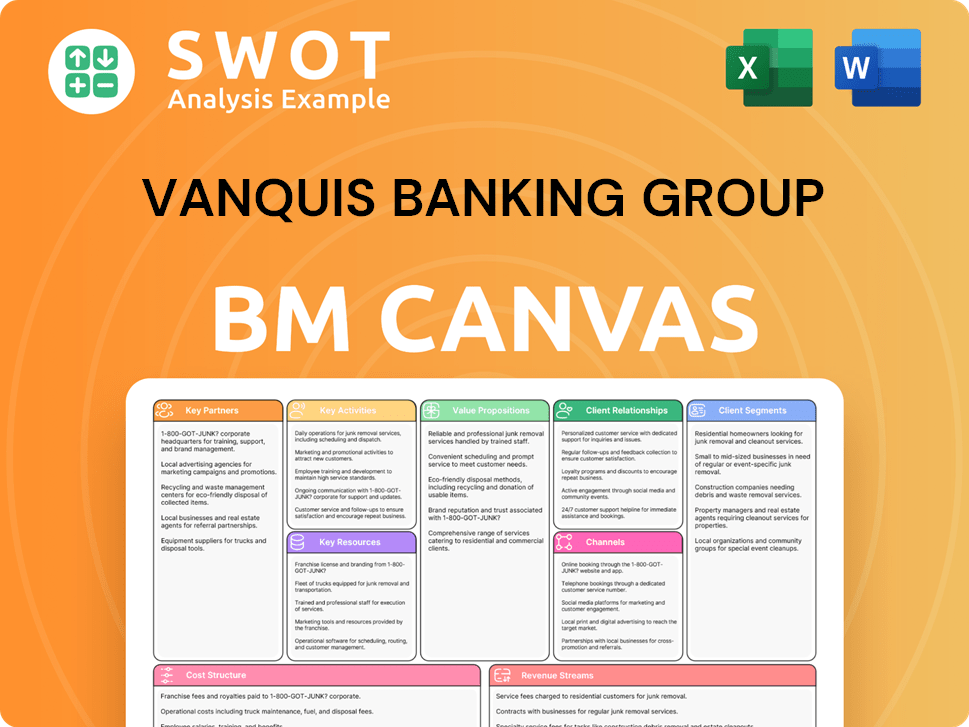Vanquis Banking Group Bundle
Can Vanquis Banking Group Achieve Sustainable Growth?
Vanquis Banking Group, a financial services provider with roots dating back to 1880, is navigating a dynamic banking industry landscape. The company, known for its credit cards and financial products, is currently undergoing a significant transformation. This exploration delves into Vanquis Banking Group's Vanquis Banking Group SWOT Analysis, growth strategy, and future prospects within the UK market and beyond.

Understanding the future of Vanquis Banking Group requires a deep dive into its strategic initiatives and market positioning. The company's focus on financial inclusion and customer-centric products is key to its long-term strategy. We will examine the potential impact of economic factors, regulatory changes, and competitive pressures on Vanquis Banking Group's financial performance and expansion plans, offering insights into investment opportunities and sustainable growth strategies within the banking industry.
How Is Vanquis Banking Group Expanding Its Reach?
The Growth Strategy of Vanquis Banking Group is focused on expanding its business and achieving sustainable growth. The company aims to serve a broader market with an enhanced customer proposition. This strategy involves a disciplined approach to growth across its product range, with a focus on specific areas.
In 2025, Vanquis Banking Group plans for accelerated growth across its product offerings. The company is prioritizing growth in Second Charge Mortgages and Credit Cards. They are also focusing on measured new business growth in Vehicle Finance. Further, Vanquis intends to refine its customer propositions and boost customer engagement to drive Credit Card utilization.
Vanquis has been redeveloping its customer proposition and adjusting pricing. This is expected to lead to modest lending growth starting from the second quarter of 2024. The Group saw a return to gross customer interest-earning balance growth in the fourth quarter of 2024. This positive trend continued into January and February 2025.
The acquisition of Snoop, a consumer money management app, is a key part of Vanquis's strategy. Snoop offers a free credit score service and personalized insights. This helps customers save money, providing a unique selling proposition (USP) in the market.
Vanquis plans to expand its B2B offerings. This includes white-label credit and loan agreements through Thimbl. This expansion is part of the company's broader strategy to diversify its business and reach new customer segments.
Vanquis's expansion initiatives are designed to drive growth and enhance its market position. These initiatives include strategic acquisitions and the development of new business offerings. The company's focus on customer engagement and product innovation is central to its long-term strategy.
- Prioritizing growth in Second Charge Mortgages and Credit Cards.
- Focusing on measured new business growth in Vehicle Finance.
- Refining customer propositions and growing customer engagement.
- Extending B2B offerings through white-label agreements.
Vanquis Banking Group SWOT Analysis
- Complete SWOT Breakdown
- Fully Customizable
- Editable in Excel & Word
- Professional Formatting
- Investor-Ready Format

How Does Vanquis Banking Group Invest in Innovation?
Vanquis Banking Group is heavily investing in technology and innovation to drive its growth strategy. This focus is crucial in the rapidly evolving financial services landscape. The company's approach aims to improve efficiency, enhance customer experience, and support future expansion.
The company's strategy is centered on digital transformation. This includes upgrading its technological infrastructure and implementing advanced digital solutions. These initiatives are designed to meet the changing needs of customers and maintain a competitive edge within the banking industry.
The company is committed to leveraging technology to provide better services. This commitment is evident in its investments in new platforms and systems. These investments are expected to enhance operational efficiency and improve the overall customer experience.
The 'Gateway' program is a key initiative. It is scheduled for completion by mid-2026. The goal is to create a scalable, digital-first platform.
The 'Gateway' program is expected to deliver significant cost savings. These savings are estimated to be between £23 million and £28 million.
Vanquis is the first bank to adopt Fiserv's Vision NextTM platform. This will accelerate digital transformation and improve payment solutions.
In 2024, Vanquis focused on enhancing the digital banking experience. This involved using scalable tech solutions and integrating AI-driven systems.
AI-automated complaint logging was implemented. The Genesys telephony system was also integrated to reduce backlogs and boost efficiency.
The Genesys Contact Centre platform is a key part of the transformation. The first phase was successfully completed in January 2024.
Vanquis acquired the Snoop platform, which uses AI and open banking data. This platform provides personalized insights to help customers save money on household bills.
- The Snoop platform targets savings of up to £1,500 per year for customers.
- The Genesys Contact Centre platform offers flexibility and scalability.
- The implementation of AI capabilities from Genesys aims to improve customer interaction and management.
- These technological advancements support the company's long-term growth strategy within the banking industry.
Vanquis Banking Group PESTLE Analysis
- Covers All 6 PESTLE Categories
- No Research Needed – Save Hours of Work
- Built by Experts, Trusted by Consultants
- Instant Download, Ready to Use
- 100% Editable, Fully Customizable

What Is Vanquis Banking Group’s Growth Forecast?
The financial outlook for Vanquis Banking Group is focused on achieving sustainable profitability. Despite facing challenges, including a statutory pre-tax loss of £136.3 million for the year ended December 31, 2024, the company is implementing strategic initiatives to drive future growth. This includes a significant focus on cost savings and revenue expansion to improve financial performance.
Vanquis Banking Group's Growth Strategy involves a multi-faceted approach to improve its financial standing. This includes cost-saving measures and strategies to increase revenue. The company aims to leverage its strong capital position and liquidity to support its growth plans. The company's focus on digital transformation and new product development is also expected to contribute to its long-term success.
The company's strategic direction is geared towards achieving a low single-digit Return on Tangible Equity (ROTE) in 2025, with a goal to reach mid-teens ROTE in 2027. This demonstrates a commitment to improving profitability and creating value for shareholders. The company's ability to navigate the competitive landscape and adapt to changing market conditions will be critical to achieving its financial objectives. For a deeper understanding of the competitive environment, consider exploring the Competitors Landscape of Vanquis Banking Group.
Vanquis Banking Group reported a statutory pre-tax loss of £136.3 million for the year ended December 31, 2024. This was a significant change from the £12.0 million loss in the prior year. The results were impacted by a goodwill write-off of £71.2 million and increased impairment charges.
Total income for 2024 decreased by 6% to £458.5 million. Net interest income fell by 5% to £420 million, primarily due to a higher cost of funds. Despite these challenges, the company is focused on revenue growth through strategic initiatives.
Vanquis made significant progress on cost-saving commitments, achieving over £64 million in savings by the end of 2024, exceeding its £60 million target. An additional £15 million in committed savings are planned by the end of 2025. These savings are crucial for improving profitability.
The company's Tier 1 capital ratio stood at 18.8% at the end of 2024, which ensures sufficient capital for future growth. Retail funding increased to 92.1% of all funding, reinforcing a strong liquidity position. These metrics support the company's financial stability.
Vanquis aims for a low single-digit Return on Tangible Equity (ROTE) in 2025, with a goal to achieve sustainable mid-teens ROTE in 2027 and double-digit ROTE in 2026. Revenue is forecast to grow by 16% per annum, and earnings are projected to grow by 87.4% per annum over the next three years. The Group's forecasted annual EBITDA for 2025 is £219 million.
- Achieving sustainable profitability is a key focus.
- Revenue growth and earnings projections indicate positive momentum.
- Strong capital and liquidity positions support future growth.
- Cost-saving measures are crucial for improving financial performance.
Vanquis Banking Group Business Model Canvas
- Complete 9-Block Business Model Canvas
- Effortlessly Communicate Your Business Strategy
- Investor-Ready BMC Format
- 100% Editable and Customizable
- Clear and Structured Layout

What Risks Could Slow Vanquis Banking Group’s Growth?
Vanquis Banking Group faces several potential risks and obstacles as it pursues its growth strategy. The banking industry, and the broader financial services sector, are subject to intense market competition and evolving regulatory changes. These elements present ongoing challenges that the company must navigate.
Operational risks, such as those related to customer complaints, can significantly impact Vanquis Banking Group's financial performance. The rise in third-party complaint submissions and associated costs, even if most complaints are not upheld, demonstrates the need for robust risk management. Technological disruption and uncertainties in the vehicle finance sector add further complexities to the company's outlook.
The company's vehicle finance business faces challenges. The future application of a Court of Appeal judgment concerning motor finance commission disclosures remains highly uncertain. The company is exploring proactive legal steps to address complaint situations. Management assesses and prepares for these risks through various measures, including a recalibrated risk framework for sustainable, risk-adjusted returns.
Vanquis Banking Group experienced a significant increase in complaint costs. Complaint costs rose by 66% to £47.4 million in 2024, impacting profitability.
Financial Ombudsman Service (FOS) fees increased threefold in 2024. FOS fees specifically reached £24.8 million, highlighting the impact of regulatory costs.
A goodwill write-off of £71.2 million was recognized in 2024 at Moneybarn, affecting the vehicle finance segment. This reflects the risks associated with this business area.
The future application of a Court of Appeal judgment regarding motor finance commission disclosures remains highly uncertain. A Supreme Court appeal outcome is not expected before July 2025, creating legal and financial risks.
Technological disruption poses an ongoing risk to Vanquis Banking Group. The company is actively mitigating this through its 'Gateway' transformation program.
The revised FOS fee structure, implemented on April 1, 2025, charges Claims Management Companies (CMCs) an upfront fee for each claim. This is expected to reduce unmerited referrals.
Vanquis Banking Group is taking proactive measures to manage its risks. These include a recalibrated risk framework designed for sustainable, risk-adjusted returns. The company is also exploring legal steps to address complaint situations and adapting to regulatory changes.
The future prospects of Vanquis Banking Group depend on its ability to navigate these challenges effectively. It must manage costs, adapt to technological changes, and address legal uncertainties. The company's strategic initiatives are key to its long-term success.
Vanquis Banking Group Porter's Five Forces Analysis
- Covers All 5 Competitive Forces in Detail
- Structured for Consultants, Students, and Founders
- 100% Editable in Microsoft Word & Excel
- Instant Digital Download – Use Immediately
- Compatible with Mac & PC – Fully Unlocked

Related Blogs
- What are Mission Vision & Core Values of Vanquis Banking Group Company?
- What is Competitive Landscape of Vanquis Banking Group Company?
- How Does Vanquis Banking Group Company Work?
- What is Sales and Marketing Strategy of Vanquis Banking Group Company?
- What is Brief History of Vanquis Banking Group Company?
- Who Owns Vanquis Banking Group Company?
- What is Customer Demographics and Target Market of Vanquis Banking Group Company?
Disclaimer
All information, articles, and product details provided on this website are for general informational and educational purposes only. We do not claim any ownership over, nor do we intend to infringe upon, any trademarks, copyrights, logos, brand names, or other intellectual property mentioned or depicted on this site. Such intellectual property remains the property of its respective owners, and any references here are made solely for identification or informational purposes, without implying any affiliation, endorsement, or partnership.
We make no representations or warranties, express or implied, regarding the accuracy, completeness, or suitability of any content or products presented. Nothing on this website should be construed as legal, tax, investment, financial, medical, or other professional advice. In addition, no part of this site—including articles or product references—constitutes a solicitation, recommendation, endorsement, advertisement, or offer to buy or sell any securities, franchises, or other financial instruments, particularly in jurisdictions where such activity would be unlawful.
All content is of a general nature and may not address the specific circumstances of any individual or entity. It is not a substitute for professional advice or services. Any actions you take based on the information provided here are strictly at your own risk. You accept full responsibility for any decisions or outcomes arising from your use of this website and agree to release us from any liability in connection with your use of, or reliance upon, the content or products found herein.